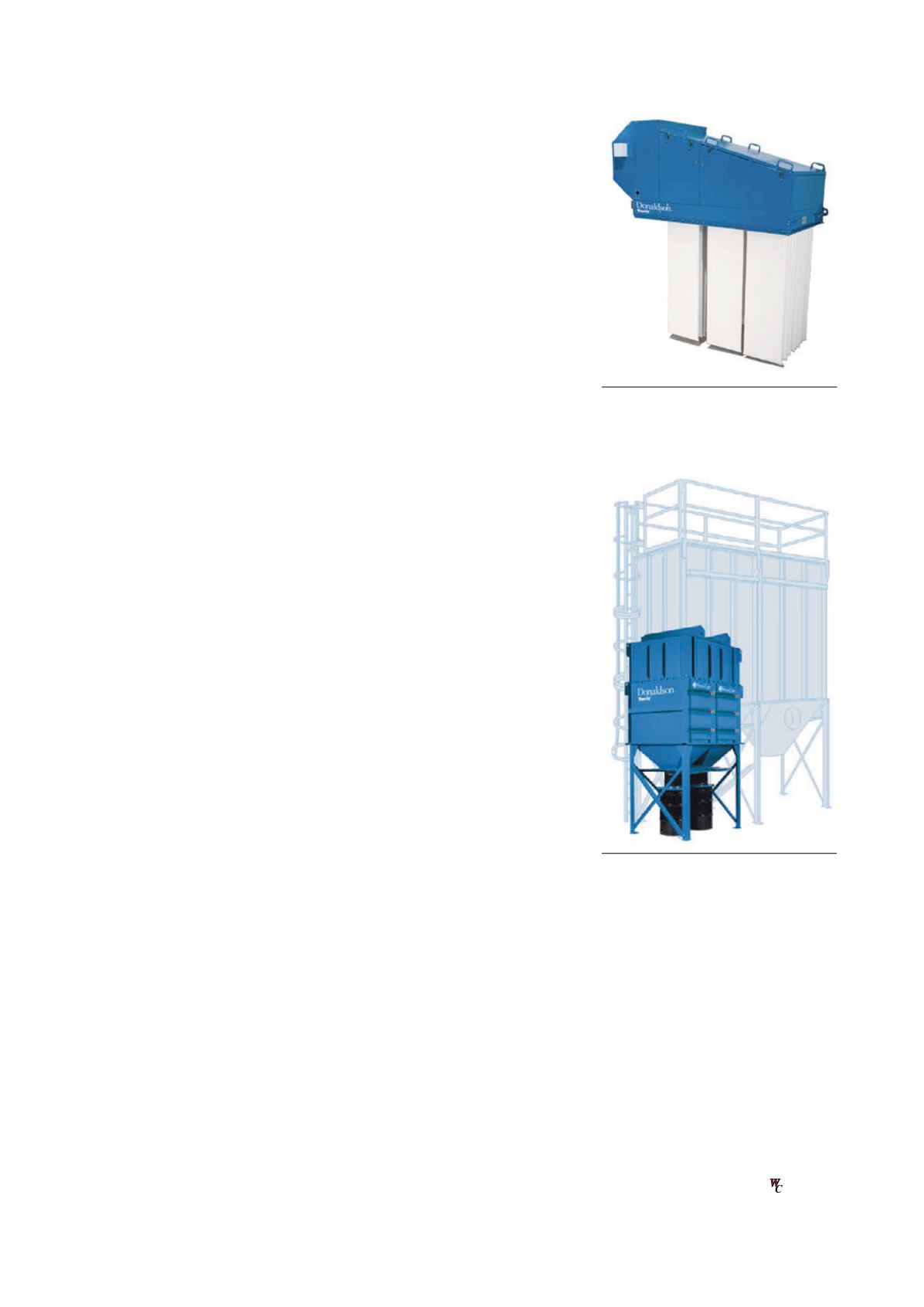
A point-of-use dust collector can
return the filtered coal dust back to the
process stream instead of removing and
disposing of it as a separate waste
stream. Newer point-of-use dust
collectors have filter packs with
vertically positioned flutes to minimise
the amount of dust that stays in the
filters. As a consequence, more dust is
cleaned back out of the filter during
each cleaning pulse, leaving less dust in
the filter during the last cleaning cycle.
Also, the collector can be configured
without a collector hopper in a ‘bin
vented style’ point-of-use dust collector,
meaning there is no final hopper dump
at the end of the cycle. Overall cleanup
time is minimised and disposal costs
are reduced.
Another benefit of using smaller,
compact point-of-use dust collectors is
that they can operate independently so
the entire dust collection system is not
down if maintenance needs to be
performed. This feature also allows a
tailored percentage of dust control to be
operated on an as-needed basis, rather
than running continuously as in a
centralised collector approach. This
saves on fan horsepower and
operational costs. Smaller point‑of‑use
collectors can also be placed indoors,
which may be preferred in a cold
climate. Indoor dust collectors avoid
condensation issues on the interior
surfaces of collectors and allow
maintenance work to be completed
inside, away from harsh weather
environments, which is a benefit for
employees.
If a bag filter is preferred – but there
is a need to incorporate some of the
benefits from a point-of-use solution – a
few existing baghouse technologies
have been redesigned and reduced in
size to allow them to be located on or
near the process. This style of bin vent
filter bag dust collector provides the
benefit of a smaller design and can be
installed indoors or outside, but still
uses filter bag technology, which
includes a wide variety of filter media
options (Figure 3).
Centralised dust
collectors
Centralised dust collectors filter the
coal dust from multiple points in the
process stream and often handle large
quantities of air. Since the collector is
typically located away from the
process, the resulting larger size of the
collector usually does not create
concerns. Many significant technology
improvements have been made to
these types of dust collectors,
providing a wider range of options
and benefits.
New centralised dust collector
designs have been optimised to include
some of the same benefits realised from
point-of-use collectors. For example,
Donaldson Torit
®
PowerCore
®
VH
collectors use updated filter technology
that is specially designed for abrasive
applications. This may be the best
solution for a facility, as it still uses a
centralised dust collection approach,
but has a much smaller footprint than a
traditional baghouse dust collector
(Figure 4), allowing it to be used
indoors or outdoors.
One situation where a traditional
centralised dust collector may be the
best solution is in the absence of a
reliable compressed air supply.
Compressed air is required for reverse
pulse cleaning in most of the dust
collectors previously discussed. If
compressed air is not available or is not
easily accessible to the dust collector
location, this may be a key
consideration in the selection process.
Because some traditional centralised
dust collectors use medium-pressure
reverse-flow air for cleaning and do not
require compressed air, they may be the
best selection for a facility.
Choosing the right dust
collection technology
How does one pick the right dust
collector solution for their facility?
First, consider what type of coal dust
is to be collected, as well as the
existing guidelines and regulations
for the industry and facility. Then
review the different options available
to determine what features would be
most beneficial to the facility. Ask: is it
more important to minimise dust
collector footprint, have an easy filter
change-out, maintain only one dust
collector, optimise fan operational
hours, reduce compressed air
dependence or reduce product
disposal? Is there a particular dust
collection method that can get most
– if not all – of what an operator
needs?
For help answering these
questions, it is best to work with a
reputable dust collection technology
provider that offers a full range of
products and has the expertise to
discuss each possible solution to
ensure the operator gets exactly what
they need for their facility.
Figure 3. Baghouse technologies have
been redesigned and reduced in size,
allowing them to be located on or near
the process.
Figure 4. The Donaldson Torit
PowerCore
®
VH collector delivers
centralised dust collection with a smaller
footprint than traditional baghouse dust
collectors, allowing it to be used indoors
or outdoors.
March 2016
|
World Coal
|
59


